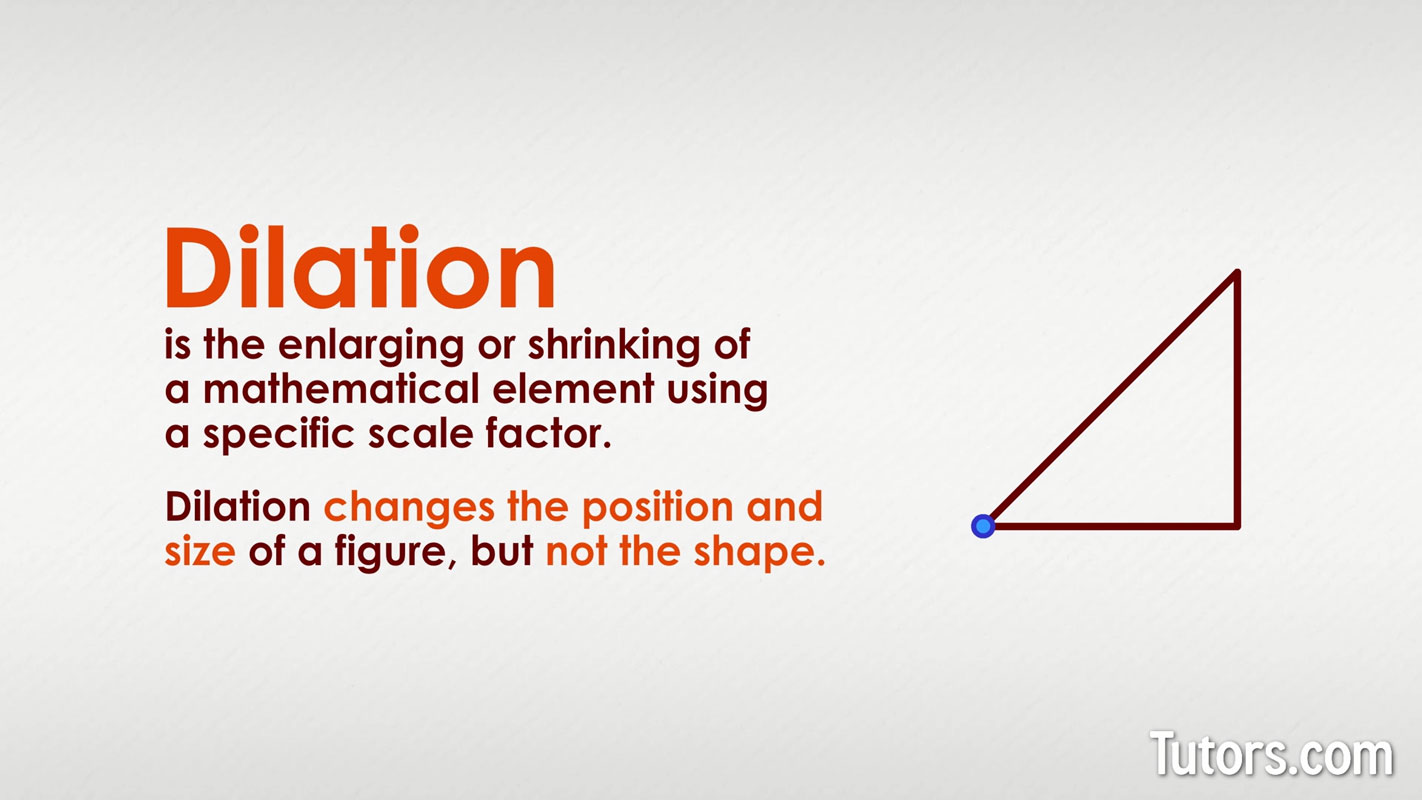Dilation in Math (Definition & Examples)
Dilation definition
Dilation is the enlarging or shrinking of a mathematical element (a point on a coordinate grid, polygon, line segment) using a specific scale factor. Dilation is one of the five major transformations in geometry. Dilation does not change the shape of the object from preimage to image, only it's position.
Center of dilation
All dilations begin with a center. This can be a single point on a coordinate grid, the middle of a polygon, or any fixed point in space.

From that center of dilation, the preimage – the mathematical element before scaling – is enlarged, inverted, or shrunk to form the image. The preimage and image are similar figures.
You can think of the preimage as the original figure, and the image as the new figure.
Here is a square. Its center of dilation is its exact middle, so any dilation from the square will still be a square with all parts equidistant from the center point:

The center of the dilation does not need to be inside the shape. It could be one vertex of the polygon. Here we still have a square as the preimage, but the center of the dilation is the top-left vertex, so the dilated images (one smaller, one larger) all share that same vertex.
Scale factor of dilation
The scale factor of a dilation is the amount by which all original terms are enlarged or shrunk, usually on a coordinate plane. If you multiply the original coordinates:
By whole numbers other than 1, you enlarge the preimage in producing the image.
By 1, you produce an image congruent to the preimage.
By fractions or decimals, you shrink the preimage to produce the image.
By negative numbers, you will produce an image that is the inverse (upside down) of the preimage, equidistant from the center of dilation but on the opposite side.

Dilation examples
Let's see the scale factor at work on a coordinate plane. Here is a trapezoid on a coordinate grid with the origin (0, 0) as the center of dilation:

f we choose a scale factor of 2, every plotted point on the polygon will be multiplied by 2 to create the enlarged image.
Take the coordinates of vertex A in the preimage at (-2, 1) and multiply times 2, producing (-4, 2) as the new A' for the image.
Vertex D in the preimage at (-3, -1) becomes D' at (-6, -2) for the image.
Can you calculate the coordinates for vertices B' and C'?
Point B at (1, 1) enlarges to B' at (2, 2)
Point C at (3, -1) enlarges to C' at (6, -2)
The image or enlargement has sides twice the length of the original preimage trapezoid. The new dilation is also the same shape as the preimage. The two polygons are similar:

Notice that the vertices of our image points share almost the same designation as the preimage vertices, but with the prime indicator: A', B', C', D'.
The trapezoid used our origin (0, 0) as the center of dilation. You can move the center to any place on the coordinate plane you wish. The "distance" from the center of the dilation to each point is calculated as the difference between the two sets of coordinate points. Here is a point (4, 5) with the center of dilation at (1, 3). You are asked to plot the image point using a scale factor of 4.

You are essentially calculating the slope of the line from the center of dilation to both coordinate pairs (preimage and image):
Center of Dilation (1, 3)
Plotted point at (4, 5)
Scale Factor 4
The plotted point of our preimage is 3 horizontal units away from the center of dilation. It is 2 vertical units away. Multiplying these distances times the scale factor, 4, means our new point must be 12 horizontal (x-axis) units from the center of dilation, and 8 vertical (y-axis) units from the same center of dilation, at (13, 11).
You can check this by drawing a line from the center of dilation through the preimage point. The dilation (image) must lie on that line, which it does.
Dilations not on the coordinate plane
When you do not have coordinates for the points of a figure on a coordinate grid, you must calculate each line segment of the figure and multiply it times the absolute value of the scale factor:
If the scale factor is negative, you will be going in the opposite direction from the point of dilation, but you must take the absolute value to get the actual distance. (Physical distances cannot be negative.)
Suppose you have a preimage of a polygon with a side, AB, 9 cm long, and a scale factor of -6. The |-6| is 6, so the image will be larger by a factor of 6. This makes side A'B' 54 cm long.

This new side will be opposite the center of dilation from the preimage, as will all the other sides of the polygon since the scale factor was negative.
Suppose you have a preimage of a polygon with a side CD that is 9 cm long and a scale factor of . In this case, the image side C'D' will be the preimage length, or 3 cm.